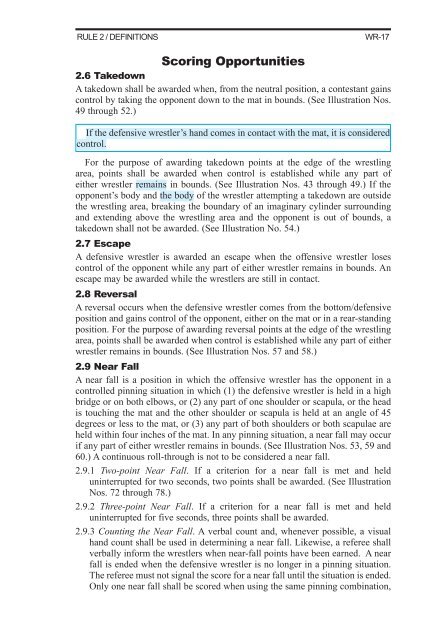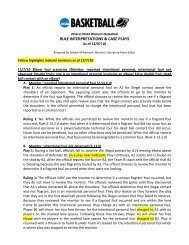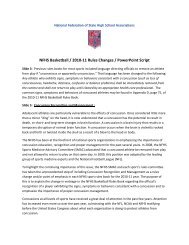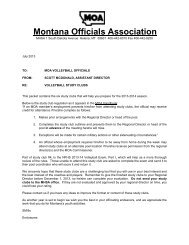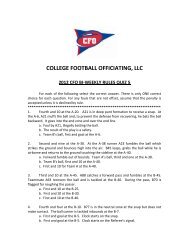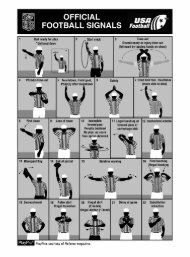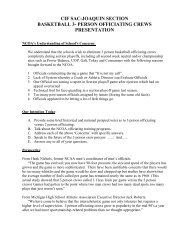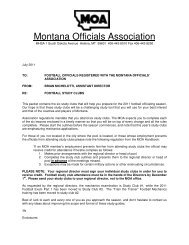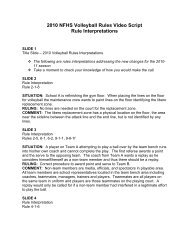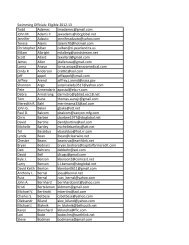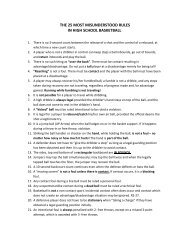(PDF). - NCAA Wrestling Officiating
(PDF). - NCAA Wrestling Officiating
(PDF). - NCAA Wrestling Officiating
Create successful ePaper yourself
Turn your PDF publications into a flip-book with our unique Google optimized e-Paper software.
Rule 2 / DefinitionsWR-17<br />
Scoring Opportunities<br />
2.6 Takedown<br />
A takedown shall be awarded when, from the neutral position, a contestant gains<br />
control by taking the opponent down to the mat in bounds. (See Illustration Nos.<br />
49 through 52.)<br />
If the defensive wrestler’s hand comes in contact with the mat, it is considered<br />
control.<br />
For the purpose of awarding takedown points at the edge of the wrestling<br />
area, points shall be awarded when control is established while any part of<br />
either wrestler remains in bounds. (See Illustration Nos. 43 through 49.) If the<br />
opponent’s body and the body of the wrestler attempting a takedown are outside<br />
the wrestling area, breaking the boundary of an imaginary cylinder surrounding<br />
and extending above the wrestling area and the opponent is out of bounds, a<br />
takedown shall not be awarded. (See Illustration No. 54.)<br />
2.7 Escape<br />
A defensive wrestler is awarded an escape when the offensive wrestler loses<br />
control of the opponent while any part of either wrestler remains in bounds. An<br />
escape may be awarded while the wrestlers are still in contact.<br />
2.8 Reversal<br />
A reversal occurs when the defensive wrestler comes from the bottom/defensive<br />
position and gains control of the opponent, either on the mat or in a rear-standing<br />
position. For the purpose of awarding reversal points at the edge of the wrestling<br />
area, points shall be awarded when control is established while any part of either<br />
wrestler remains in bounds. (See Illustration Nos. 57 and 58.)<br />
2.9 Near Fall<br />
A near fall is a position in which the offensive wrestler has the opponent in a<br />
controlled pinning situation in which (1) the defensive wrestler is held in a high<br />
bridge or on both elbows, or (2) any part of one shoulder or scapula, or the head<br />
is touching the mat and the other shoulder or scapula is held at an angle of 45<br />
degrees or less to the mat, or (3) any part of both shoulders or both scapulae are<br />
held within four inches of the mat. In any pinning situation, a near fall may occur<br />
if any part of either wrestler remains in bounds. (See Illustration Nos. 53, 59 and<br />
60.) A continuous roll-through is not to be considered a near fall.<br />
2.9.1 Two-point Near Fall. If a criterion for a near fall is met and held<br />
uninterrupted for two seconds, two points shall be awarded. (See Illustration<br />
Nos. 72 through 78.)<br />
2.9.2 Three-point Near Fall. If a criterion for a near fall is met and held<br />
uninterrupted for five seconds, three points shall be awarded.<br />
2.9.3 Counting the Near Fall. A verbal count and, whenever possible, a visual<br />
hand count shall be used in determining a near fall. Likewise, a referee shall<br />
verbally inform the wrestlers when near-fall points have been earned. A near<br />
fall is ended when the defensive wrestler is no longer in a pinning situation.<br />
The referee must not signal the score for a near fall until the situation is ended.<br />
Only one near fall shall be scored when using the same pinning combination,


